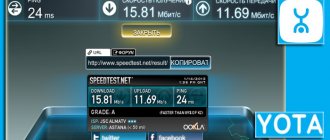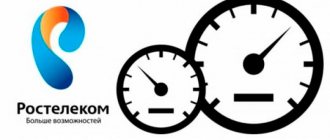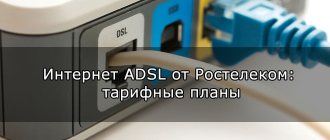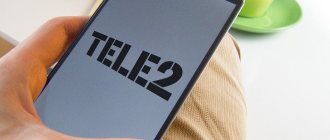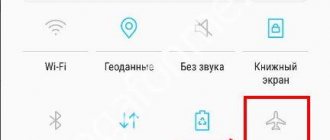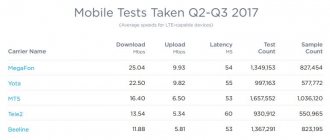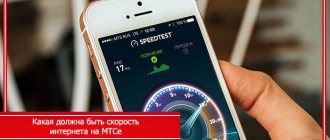What is the speed of the 4G standard? This is a frequently asked query in search engines. It is of interest to users who have already switched or are planning to switch to using the fourth generation mobile network. However, before replacing the SIM card in your smartphone or modem with a new one, it is worth finding out what is the difference between third and fourth generation technologies, what is the difference in speed, stability and quality of coverage.
Mobile Internet is developing rapidly, replacing other types of communications. Operators are constantly working to improve quality and speed, but how does this affect the subscriber experience?
In domestic conditions and throughout the world, there are certain operator games. They consist in the fact that the full name of the technology is presented as 4G LTE. However, LTE is a fourth generation standard, but in fact it is an improved 3G. It definitely does not have the characteristics of a full-fledged fourth generation.
Note! The development and regulation of the cellular communications market is carried out by a special organization - the International Telecommunication Union. It introduced 4G Internet in 2008. Since then, there has been constant development and smooth implementation of it throughout the world.
Speed
The technology is based on the packet principle of information transfer. This makes it possible to obtain such impressive declared application speeds as 1 Gbit/sec. But such a high real speed of the 4G standard is difficult to achieve, and not a single global network can boast of such a result.
Base stations, or simply towers, of various operators are capable of transmitting data over a distance of 100 km. But this requires a perfectly flat area without various obstacles: hills, ravines, forests, etc.
Special protocols of the International Telecommunication Union have established Internet speed as a standard, which must be at least 100 Mbit/s for objects in motion. As for fixed terrestrial access points, that is, modems or static phones, the transmission speed should be up to 1 Gbit/s. However, today the actual numbers are much lower.
Note! The speed very much depends on the distance to the base station and the presence of obstacles.
The maximum efforts of developers today are directed towards the use of orthogonal frequency division multiplexing (OFDM) technology. For users who have access to data transmission using a modem, a good way to enhance the quality and speed of transmitted and received traffic is MIMO technology. This means that the antennas for receiving and transmitting information are located so that the greatest correlation is obtained in nearby devices.
Regarding the differences between 4G and the third generation standard, its support is fully functional using the packet method. This gives greater speed and throughput. 3G can boast only partial packet transmission, while the largest part is still taken up by channel transmission. Voice messages are sent and received using Voice over LTE.
Important! In Russian cities, 4G speed is quite good, but the same cannot be said about suburbs and remote areas.
Center of the VDNH metro hall
In the evening there are always a lot of people here, especially in the metro. Near the metro entrance the indicators were approximately the same.
On the left is MegaFon , on the right is MTS
Beeline
on the left , Tele2
Yota
results:
▪️ MegaFon - 15.2 Mbit/s ▪️ MTS - 44.3 Mbit/s ▪️ Beeline - 2.74 Mbit/s ▪️ Tele2 - 15.2 Mbit/s ▪️ Yota - 130 Mbit/s
Result : Yota won this round.
What factors affect speed?
It is noteworthy that, after carrying out one test and after a while another, without moving the phone, you can notice that the speed is constantly changing. This is due to various factors, the appearance or disappearance of frequency interference, the movement of large objects and other reasons.
How to determine normal Internet speed
However, there is a certain set of factors that affect the operation of the mobile network:
- distance of the user's device to the operator's base station. For some networks, operators further limit coverage areas. In this case, the phone, modem or tablet will show that they are within the 4G network, but the speed will not be high;
- If the subscriber is in the city, then the absence of interference is of great importance. The fewer there are, the better the quality of Internet use will be. In addition, the main problem is the presence of signals reflected several times from different surfaces;
- directly affects the number of users simultaneously connected to the relay antenna. There is also an indirect factor - the time period of application. At night, the speed is consistently higher, because most subscribers simply do not use the Internet;
- technical characteristics of a smartphone, tablet or modem. Even among one manufacturer, the use of fourth generation networks for data exchange is radically different for flagship models and budget lines.
The development of mobile communications does not stand still, so providers are developing standards and technologies.
Note! Equipment and software are constantly being improved to provide subscribers with the most stable and high-quality connection with high throughput.
YouTube Recommended Bitrate (HDR)
HDR content on YouTube consumes more data - the recommended bitrate for FHD is 30 fps, HDR is 10 Mbps , and 60 fps increases the requirement to 15 Mbps. So theoretically, every minute consumes about 75 MB of data.
Speed difference between fourth and third generations
Third generation technology is a mobile standard for information transfer with the possibility of high-speed access to the Global Network and mobile communications. The date of creation is 1999. Despite this, the real implementation and distribution of 3G began later. The popularity of 3G is still the highest among all mobile operators.
How to check MGTS Internet speed: on a computer or phone
In domestic conditions, the coverage area of the 3G standard is much greater than the coverage of the follower. In addition, this greatly affects the actual speed, since 3G operates at its maximum capabilities, while newer communications only work fully in cities.
Today, the only problem with the 3G standard is its lower speed compared to the fourth generation. It amounts to:
- for users with a high level of mobility (up to 120 km/h) - at least 144 Kbps;
- for users with a low level of mobility (up to 3 km/h) - 384 Kbps;
- for stationary objects - 2048 Kbps.
4G data transfer speeds are:
- the 4G LTE standard boasts a data transfer speed of real 60 Mbit/s;
- speeds of 100 Mbit/s should be provided to highly mobile users, such as trains and cars in motion;
- Users with low mobility, such as pedestrians and fixed-line subscribers, should be provided with 1 Gbit/s speed.
When compared in detail, it becomes clear that the fourth generation technology is 10 times or more faster than its predecessor. In addition, 4G has a number of advantages. For example, if the coating or connection is of poor quality, it is automatically replaced with an older one. In the case of 3G, the same thing happens, but there the previous minimum standard is EDGE, the appearance of which clearly does not please subscribers.
Note! The process of changing the standard in the case of a newer one is as smooth as possible, and even downloads or voice data transfers are not interrupted. This is due to the use of the packet transfer method.
It is clear that fourth generation technology works and should function much faster, because it is a newer step in the evolution.
Red Square Center
The first and most important place for testing is right in the middle of Red Square, where there are always a lot of tourists and just vacationers.
On the left
is MegaFon , on the right is MTS
Beeline
on the left , Tele2
Yota
results:
▪️ MegaFon - 10.3 Mbit/s ▪️ MTS - 40.5 Mbit/s ▪️ Beeline - 10.7 Mbit/s ▪️ Tele2 - 12.9 Mbit/s ▪️ Yota - 24.5 Mbit/s
Result : MTS won this round.
How to check speed
It is important for any user to know how to check the performance of the mobile network. There are many different sites and applications for this. You can choose the most convenient method and use it. One of the first such sites is Speedtest.net. It is available as a program, an application for smartphones. You can also check your speed by going directly to the site. The program shows download, transfer and ping speeds.
Connecting and setting up 4G mobile Internet on iPhone
The principle of operation is that the program connects to the nearest server at the base station and takes measurements of various indicators. This allows you to measure the speed of information transfer as accurately as possible.
Note! During the measurement, you need to stop all downloads and close third-party applications that use the Internet. This will allow you to achieve the most accurate and high-quality measurements. It is also advisable to be stationary, otherwise the speed of the Network may change dramatically. In this case, it will be impossible to get a real result.
Satellite Internet
The most rare, but promising connection option. Now it is used mainly by business representatives and residents in rural areas where there are no alternative connection options.
A set of equipment may include several devices. Included with this:
- satellite dish,
- transmitting and receiving device
- satellite modem.
The approximate cost of equipment for satellite Internet starts from 9990 rubles (Tricolor, on promotion), and access fees: from 1300 to 5000-6000 or more rubles per month.
However, competition in the satellite Internet market is constantly increasing, which naturally leads to lower prices. Breakthrough technologies and cheap satellite Internet are promised to the entire planet by Elon Musk - on May 24, 2021, his company SpaceX has already launched 60 low-orbit satellites, the number of which is planned to be increased to 11,943.
The signal from all these satellites will be transmitted with minimal delay to compact ground terminals (no larger than a laptop), and then sent to client devices: PCs, laptops, smartphones, etc.
Elon Musk promises record low prices and high speed of information transfer - the company’s ambitious plan to capture the global market applies to 50% of Internet users on the planet. All that remains is to wait for the full deployment of the network called Starlink and enjoy the Internet from space.
Frequency ranges
Most domestic mobile operators use almost identical frequency ranges for communication:
- operator "Yota" operates in 2500-2530/2620-2650 MHz;
- Megafon uses 2530-2540/2650-2660; 2575-2595; 847-854.5/806-813.5 MHz;
- for the MTS operator the frequencies are 2540-2550/2660-2670; 2595-2615; 1710-1785/1805-1880; 839.5-847/798.5-806 MHz;
- 2550-2560/2670-2680 are allocated for Beeline; 854.5-862/813.5-821 MHz;
- Tele2 operates at 2560-2570/2680-2690; 832-839.5/791-798.5 MHz.
Note! In Europe there are fewer cellular operators, so fewer frequency bands are used.
For European subscribers the following frequencies apply:
- 4G FDD Band 8 880.1 - 889.9 MHz, 925.1 - 934.9 MHz, 2x9.8 - operator "Orange France";
- 4G FDD Band 3 1710 - 1785 MHz, 1805 - 1880 MHz 2x75 - operators "Orange France", SFR, "Bouygues Telecom", "Free Mobile";
- 4G FDD Band 1 2100 MHz – 2×60 – “Orange France” only;
- 4G FDD Band 7 2500 - 2570 MHz, 2620 - 2690 - 2x75 - operators "Orange France", SFR, "Bouygues Telecom", "Free Mobile".
In the United States of America the following frequency ranges are used:
- B2 at frequencies from 1850 to 1910 MHz and from 1930 to 1990 MHz. Operators: T-Mobile, MetroPCS (General Wireless);
- B4. AT&T, T-Mobile, MetroPCS are used;
- B13 for Verizon provider;
- B2, B4, B5, B17, AT&T only;
- B25, B26, “Sprint” only.
Center of the Shchelkovskaya metro hall
They checked in the center of the hall.
On the left is MegaFon , on the right is MTS
Beeline
on the left , Tele2
Yota
results:
▪️ MegaFon - 104 Mbit/s ▪️ MTS - 83.6 Mbit/s ▪️ Beeline - 54.5 Mbit/s ▪️ Tele2 - 17.9 Mbit/s ▪️ Yota - 146 Mbit/s
Result : Yota won this round.


